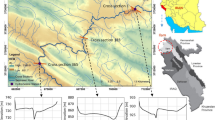Abstract
Capturing the uncertainties is of the main concerns in optimal design of floodplain systems. This study deals with risk-based optimal design of flood mitigation measures using a random sampling technique and simulation-optimization approach. An optimization-based inverse approach is developed to map flood discharges, generated by Latin Hyper Cube Sampling (LHS) technique, to the surface hydrographs of sub-watersheds. Provided hydrographs are then imported to a hydrodynamic model to calculate floodplain inundation and to estimate expected damages of generated floods underlying various flood mitigation measures. Models are coupled with NSGA-II optimization algorithm to produce Pareto optimal solutions between two competitive objectives: minimizing i) investment costs and ii) potential flood damages. The proposed approach is finally applied to a small watershed and cost-effective designs of floodplains are derived along their confident intervals. The results give valuable information to decision makers about benefit to cost ratios and the value of robustness for the obtained solutions.







Similar content being viewed by others
Notes
Digital Elevation Model
References
Abrishamchi A, Afshar A, Kerachian R (2003) Spillway capacity optimization under hydrologic uncertainties and flood routing. Iran J Sci Technol Trans B 27(B1):111–122
Afshar A, Marino MA (1990) Optimizing spillway capacity with uncertainty in flood estimator. J Water Resour Plan Manag 116(l):71–84
Afshar A, Rasekh A, Afshar MH (2009) Risk-based optimization of large flood diversion systems, using genetic algorithms. Eng Optim 41(3):259–273
Ahmad SS, Simonovic SB (2011) A three-dimensional fuzzy methodology for flood risk analysis. J Flood Risk Manag. doi:10.1111/j.1753-318X.2011.01090.x
Bialas WF, Loucks DP (1978) Nonstructural floodplain planning. Water Resour Res 14(1):67–74
Chill J, Mays LW (2013) Determination of the optimal location for developments to minimize detention requirements. Water Resour Manag 27:5089–5100
Chow VT, Maidment DR, Mays LW (1988) Applied hydrology. McGraw-Hill, New York
Day JC (1970) A recursive programming model for non-structural flood damage control. J Water Resour Res 4(5):1262–1271. doi:10.1029/WR006i005p01262
Deb K, Agrawal S, Pratap A, Meyarivan T (2000) A fast elitist non-dominated sorting genetic algorithm for multi-objective optimization: NSGA-II. In: Schoenauer M, Deb K, Rudolph G, Yao X, Lutton E, Merelo JJ, Schwefel H-P, (eds) Proceedings of the parallel problem solving from nature VI Conference (Lecture Notes in Computer Science No. 1917), Springer, pp 849–858
Delelegn SW, Pathirana A, Gersonius B, Adeogun AG, Vairavamoorthy K (2011) Multi-objective optimisation of cost–benefit of urban flood management using a 1D2D coupled model. Water Sci Technol 63(5):1053–1059
DHI (2007) MIKE11, a modeling system for rivers and channels, user manual. Danish Hydraulic Institute, Denmark
Karamouz M, Abesi O, Moridi A, Ahmadi A (2008) Development of optimization schemes for floodplain management; a case study. J Water Resour Manag. doi:10.1007/s11269-008-9350-9
Lund JR (2002) Floodplain planning with risk-based optimization. J Water Resour Plan Manag 128(3):202–207. doi:10.1061/(ASCE)0733-9496(2002)128:3(202)
Melching CS (1995) Reliability estimation. In: Singh VP (ed) Computer models of watershed hydrology. Water Resources Publications, Highlands Ranch, pp 69–118
Morin TL, Merier WL, Nagaraj KS (1989) In: Esogbue AO (ed) Dynamic programming for flood dynamic programming for optimal water systems analysis. Prentice-Hall, Englewood Cliffs, pp 286–306
Oxley RL, Mays LW (2014) Optimization—simulation model for detention basin system design. Water Resour Manag 28:1157–1171
Saghafian B, Khosroshahi M (2005) Unit response approach for priority determination of flood source areas. J Hydrol Eng ASCE 10(4):270–277
Sun SA, Djordjevic S, Khu ST (2011) A general framework for flood risk-based storm sewer network design. Urban Water J 8(1):13–27
Travis QB, Mays LW (2008) Optimizing retention basin networks. J Water Resour Plan Manag 134(5):432–439. doi:10.1061/(ASCE)0733-9496(2008)134:5(432)
Tung YK, Bao Y (1990) On the optimal risk-based design of highway drainage structures. Stoch Hydrol Hydraul 4(1990):295–308
Tung YK, Yen BC, Melching CS (2006) Hydrosystems engineering reliability assessments and risk analysis. McGraw-Hill, USA
USACE (2000) Hydrologic modeling system HEC-HMS, technical reference manual. US Army Corps of Engineers, Hydrologic Engineering Center, 2000, USA
WRI (2011) Technical reports of the project: “integrated flood management, case study: Kan basin”. Water Research Institute, Ministry of Energy, Iran (In Persian)
Yazdi J (2013) Optimization of flood control system on watershed scale under flood uncertainties, PhD Thesis, Faculty of Civil and Environmental Engineering, Tarbiat Modares University, Iran, April 2013 (in Persian)
Yazdi J, Salehi Neyshabouri SAA (2012) Simulation-based optimization model for flood management on a watershed scale. J Water Resour Manag 26(15):4569–4586
Author information
Authors and Affiliations
Corresponding author
Rights and permissions
About this article
Cite this article
Yazdi, J., Salehi Neyshabouri, S.A.A. An Optimization Model for Floodplain Systems Considering Inflow Uncertainties. Water Resour Manage 29, 1295–1313 (2015). https://doi.org/10.1007/s11269-014-0874-x
Received:
Accepted:
Published:
Issue Date:
DOI: https://doi.org/10.1007/s11269-014-0874-x




